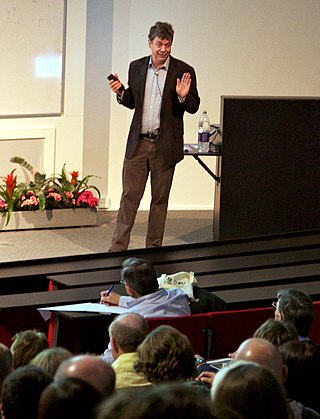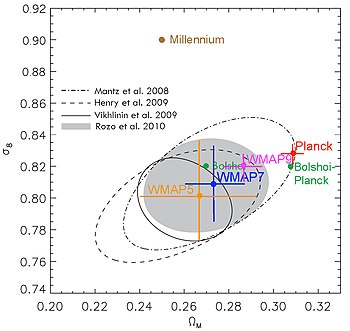
Physical cosmology is a branch of cosmology concerned with the study of cosmological models. A cosmological model, or simply cosmology, provides a description of the largest-scale structures and dynamics of the universe and allows study of fundamental questions about its origin, structure, evolution, and ultimate fate. Cosmology as a science originated with the Copernican principle, which implies that celestial bodies obey identical physical laws to those on Earth, and Newtonian mechanics, which first allowed those physical laws to be understood.

In astronomy, dark matter is a hypothetical form of matter that appears not to interact with light or the electromagnetic field. Dark matter is implied by gravitational effects which cannot be explained by general relativity unless more matter is present than can be seen. Such effects occur in the context of formation and evolution of galaxies, gravitational lensing, the observable universe's current structure, mass position in galactic collisions, the motion of galaxies within galaxy clusters, and cosmic microwave background anisotropies.

The study of galaxy formation and evolution is concerned with the processes that formed a heterogeneous universe from a homogeneous beginning, the formation of the first galaxies, the way galaxies change over time, and the processes that have generated the variety of structures observed in nearby galaxies. Galaxy formation is hypothesized to occur from structure formation theories, as a result of tiny quantum fluctuations in the aftermath of the Big Bang. The simplest model in general agreement with observed phenomena is the Lambda-CDM model—that is, clustering and merging allows galaxies to accumulate mass, determining both their shape and structure. Hydrodynamics simulation, which simulates both baryons and dark matter, is widely used to study galaxy formation and evolution.
In cosmology and physics, cold dark matter (CDM) is a hypothetical type of dark matter. According to the current standard model of cosmology, Lambda-CDM model, approximately 27% of the universe is dark matter and 68% is dark energy, with only a small fraction being the ordinary baryonic matter that composes stars, planets, and living organisms. Cold refers to the fact that the dark matter moves slowly compared to the speed of light, giving it a vanishing equation of state. Dark indicates that it interacts very weakly with ordinary matter and electromagnetic radiation. Proposed candidates for CDM include weakly interacting massive particles, primordial black holes, and axions.

The observable universe is a ball-shaped region of the universe consisting of all matter that can be observed from Earth or its space-based telescopes and exploratory probes at the present time; the electromagnetic radiation from these objects has had time to reach the Solar System and Earth since the beginning of the cosmological expansion. Initially, it was estimated that there may be 2 trillion galaxies in the observable universe. That number was reduced in 2021 to several hundred billion based on data from New Horizons. Assuming the universe is isotropic, the distance to the edge of the observable universe is roughly the same in every direction. That is, the observable universe is a spherical region centered on the observer. Every location in the universe has its own observable universe, which may or may not overlap with the one centered on Earth.

In physical cosmology, the age of the universe is the time elapsed since the Big Bang. Astronomers have derived two different measurements of the age of the universe: a measurement based on direct observations of an early state of the universe, which indicate an age of 13.787±0.020 billion years as interpreted with the Lambda-CDM concordance model as of 2021; and a measurement based on the observations of the local, modern universe, which suggest a younger age. The uncertainty of the first kind of measurement has been narrowed down to 20 million years, based on a number of studies that all show similar figures for the age. These studies include researches of the microwave background radiation by the Planck spacecraft, the Wilkinson Microwave Anisotropy Probe and other space probes. Measurements of the cosmic background radiation give the cooling time of the universe since the Big Bang, and measurements of the expansion rate of the universe can be used to calculate its approximate age by extrapolating backwards in time. The range of the estimate is also within the range of the estimate for the oldest observed star in the universe.
The cuspy halo problem is a discrepancy between the inferred dark matter density profiles of low-mass galaxies and the density profiles predicted by cosmological N-body simulations. Nearly all simulations form dark matter halos which have "cuspy" dark matter distributions, with density increasing steeply at small radii, while the rotation curves of most observed dwarf galaxies suggest that they have flat central dark matter density profiles ("cores").

The Lambda-CDM, Lambda cold dark matter, or ΛCDM model is a mathematical model of the Big Bang theory with three major components:
- a cosmological constant, denoted by lambda (Λ), associated with dark energy
- the postulated cold dark matter, denoted by CDM
- ordinary matter

In modern models of physical cosmology, a dark matter halo is a basic unit of cosmological structure. It is a hypothetical region that has decoupled from cosmic expansion and contains gravitationally bound matter. A single dark matter halo may contain multiple virialized clumps of dark matter bound together by gravity, known as subhalos. Modern cosmological models, such as ΛCDM, propose that dark matter halos and subhalos may contain galaxies. The dark matter halo of a galaxy envelops the galactic disc and extends well beyond the edge of the visible galaxy. Thought to consist of dark matter, halos have not been observed directly. Their existence is inferred through observations of their effects on the motions of stars and gas in galaxies and gravitational lensing. Dark matter halos play a key role in current models of galaxy formation and evolution. Theories that attempt to explain the nature of dark matter halos with varying degrees of success include cold dark matter (CDM), warm dark matter, and massive compact halo objects (MACHOs).

In physical cosmology, structure formation describes the creation of galaxies, galaxy clusters, and larger structures starting from small fluctuations in mass density resulting from processes that created matter. The universe, as is now known from observations of the cosmic microwave background radiation, began in a hot, dense, nearly uniform state approximately 13.8 billion years ago. However, looking at the night sky today, structures on all scales can be seen, from stars and planets to galaxies. On even larger scales, galaxy clusters and sheet-like structures of galaxies are separated by enormous voids containing few galaxies. Structure formation models gravitational instability of small ripples in mass density to predict these shapes, confirming the consistency of the physical model.
The Millennium Run, or Millennium Simulation is a computer N-body simulation used to investigate how the distribution of matter in the Universe has evolved over time, in particular, how the observed population of galaxies was formed. It is used by scientists working in physical cosmology to compare observations with theoretical predictions.
Joel R. Primack is an American physicist. He is a professor of physics and astrophysics at the University of California, Santa Cruz, and is a member of the Santa Cruz Institute for Particle Physics.
The Navarro–Frenk–White (NFW) profile is a spatial mass distribution of dark matter fitted to dark matter halos identified in N-body simulations by Julio Navarro, Carlos Frenk and Simon White. The NFW profile is one of the most commonly used model profiles for dark matter halos.

Simon David Manton White, FRS, is a British-German astrophysicist. He was one of directors at the Max Planck Institute for Astrophysics before his retirement in late 2019.

The Institute for Computational Cosmology (ICC) is a research institute at Durham University, England. It was founded in November 2002 as part of the Ogden Centre for Fundamental Physics, which also includes the Institute for Particle Physics Phenomenology (IPPP). The ICC's primary mission is to advance fundamental knowledge in cosmology. Topics of active research include: the nature of dark matter and dark energy, the evolution of cosmic structure, the formation of galaxies, and the determination of fundamental parameters.
The University of California High-Performance AstroComputing Center (UC-HiPACC) based at the University of California at Santa Cruz (UCSC) is a consortium of nine University of California campuses and three Department of Energy laboratories. The consortium's goal is to support and facilitate original research and education in computational astrophysics and to engage in public outreach and education.

The Illustris project is an ongoing series of astrophysical simulations run by an international collaboration of scientists. The aim is to study the processes of galaxy formation and evolution in the universe with a comprehensive physical model. Early results were described in a number of publications following widespread press coverage. The project publicly released all data produced by the simulations in April, 2015. Key developers of the Illustris simulation have been Volker Springel and Mark Vogelsberger. The Illustris simulation framework and galaxy formation model has been used for a wide range of spin-off projects, starting with Auriga and IllustrisTNG followed by Thesan (2021), MillenniumTNG (2022) and TNG-Cluster (2023).

Ben Moore is an English professor of astrophysics, author, musician, and director of the Center for Theoretical Astrophysics and Cosmology at the University of Zürich. His research is focussed on cosmology, gravity, astroparticle physics, and planet formation. He has authored in excess of 200 scientific papers on the origin of planets and galaxies, as well as dark matter and dark energy. In his research, he simulates the universe using custom-built supercomputers.

The UniverseMachine is a project carrying out astrophysical supercomputer simulations of various models of possible universes, created by astronomer Peter Behroozi and his research team at the Steward Observatory and the University of Arizona. Numerous universes with different physical characteristics may be simulated in order to develop insights into the possible beginning and evolution of our universe. A major objective is to better understand the role of dark matter in the development of the universe. According to Behroozi, "On the computer, we can create many different universes and compare them to the actual one, and that lets us infer which rules lead to the one we see."
The Sheth–Tormen approximation is a halo mass function.









